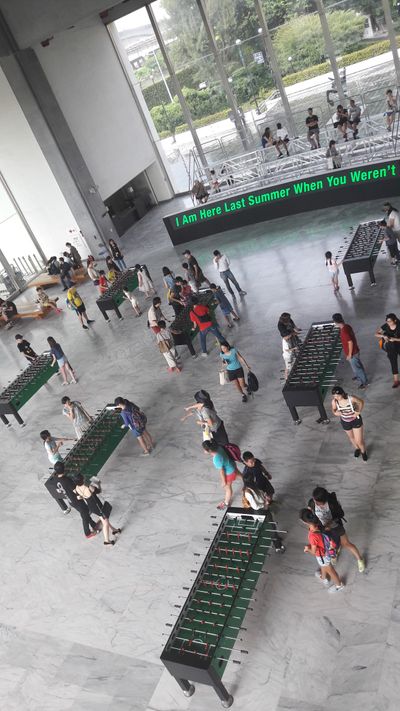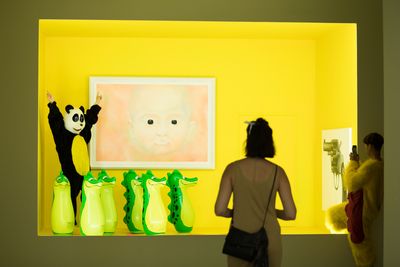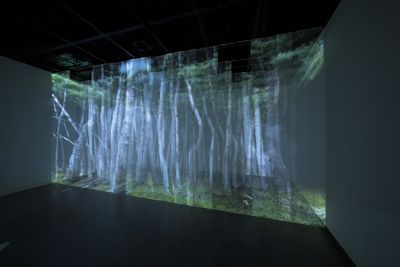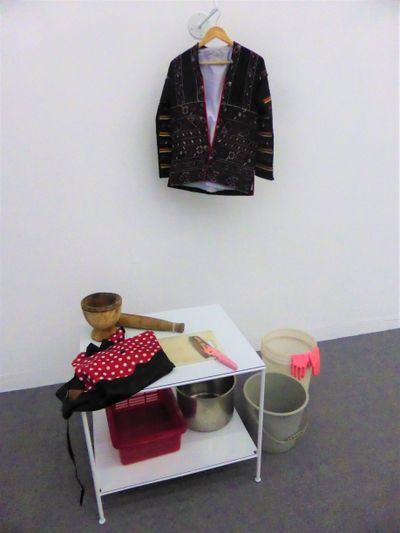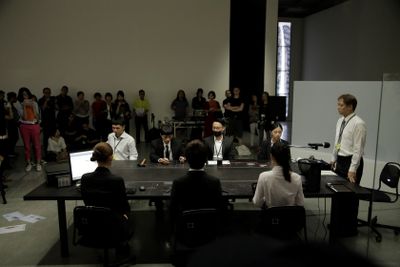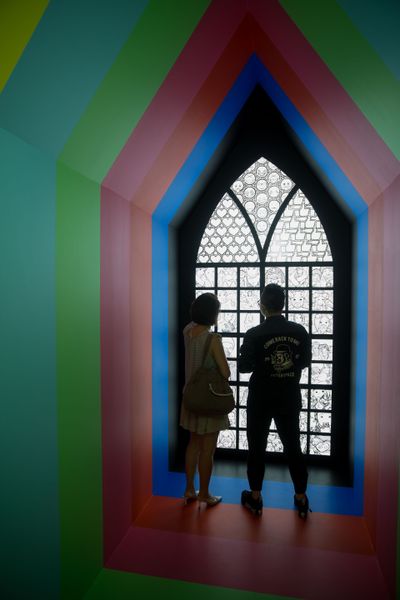A conscious cacophony: 'Arena' at Taipei Fine Arts Museum

Installation view: Against-Again Troupe and Snow Huang, Concert of Performance Review (2017). Performance. Arena, Taipei Fine Arts Museum, Taipei (8 July–17 September 2017). Courtesy Taipei Fine Arts Museum.
The range of media in Arena (8 July–17 September 2017), a joint exhibition at Taipei Fine Arts Museum (TFAM) organised with Gwangju Museum of Art, has the potential to confuse. Jo Hsiao, the exhibition's curator, might argue that this is precisely the point. With a curatorial statement that makes reference to The World as a Stage, Tate Modern's 'first theatrical exhibition' (27 October 2007–1 January 2008), Arena converges a series of performances and immersive displays with static works by Korean and Taiwanese artists including Shih-hue Tu, Wan-jen Chen, Seung-mo Park, and Yong-hyun Lim.
As a whole, the show seeks to shift the viewing of art from an experience of passive absorption to dynamic participation. The press release's mention of the human body, theatre, music, and sound conjured expectations for an arena of unexpected happenings and socially driven performances: Shiraga-esque bodies scrambling in mud, or something akin to Anne Imhof's durational performance Faust (2017) at the German pavilion in Venice (a series of bodies slowly moving in a conceptual nightmare). But what came into being was much tamer. Stepping into the museum's entrance hall, viewers are confronted with Yi-wei Keng's I Am Here Last Summer When You Weren't (2017): eight extra-long foosball tables manned primarily by children—an experience that might lead many to instantly agree with the exhibition's aim to jangle both 'nerves' and 'spirits'. The participatory work expresses the artist's desire for viewers to be present with one another and forget about distractions, namely their smartphones, while they experience art. Flanked by two metal stages, the frantic action becomes a spectacle for non-participants while calling attention to participatory dynamics. An added layer of playfulness surfaces when we consider the exhibition's conjunction with the Summer Universiade, an international multi-sport event being held in Taipei this August.
The cacophony of tables sets the tone for the rest of the exhibition, which—though seemingly lacking a thematic thread—creates a series of conscious viewing experiences. From the entrance hall, the museum's ground floor galleries are partitioned to designate space for performances, immersive and participatory installations (some focusing on sound and video), as well as static pieces that are either designated their own sections or placed pêle-mêle with other works. Within these partitions, lighting (both naked and tinted) is adjusted to instill varying degrees of immersion. In the case of Riverbed Theatre's installation we're all in this together (2017), viewers enter a bright green room through a small door to 'Be Smart, Be Courteous, Be Creative, Be Art' (as the work's manifesto declares). Inside, participants can try on different costumes and then step onto a yellow stage to pose and have their photos taken as exhibition goers stroll by; the best of which are displayed on the installation's outer wall. The unpredictable nature of these participations, as well as the gradual accumulation of photographs, allows the installation's framework to morph over time, changing the way it is approached and perceived.
In contrast with Riverbed's brightly lit stage and dressing room, darker spaces in the show incite a sense of immersion through dancing visuals and various interactions with them. There is Yong-hyun Lim's Culture Code. C (2017), consisting of colourful projections on a wall of Coke cans accompanied by catchy minimal beats; Wan-jen Chen's hypnotic looped video of animated swimmers doing lengths across a floor-bound screen in Midnight Blue (2017); and the possibility to use Google Tilt Brush to create three-dimensional images in virtual space and have them printed, courtesy of Lee-nam Lee, who is collaborating with the Google Cultural Institute in a project entitled Earth in Hybridization (2016). Mudeung Fantasia 2 (2017) by Sang-Hwa Park is another immersive piece, with its projections of forest scenes upon layers of mesh cloth that hang from the ceiling at the far end of its designated room, creating a meditative environment that is deepened by the possibility to enter and walk through the hanging veils.
While most of the works in the exhibition hold their value in the formalist sense as artworks to be experienced, there is one piece whose focus extends beyond the museum walls and into the context of the city where this exhibition is staged. Voleur du Feu Theatre's (Tung-ning Hsieh and Mu-yun Ho) Drifting Square (2017) is perhaps the most socially oriented installation in the show. Within a designated room, six speakers hang from the ceiling and emit recordings of interviews between the artists and different migrant workers in Taipei. For each migrant worker, a careful selection of personal belongings is exhibited alongside their respective speaker so that a physical dimension is attributed to the interview. Placed on tables, chairs or the floor, the items stand for personal interests, desires, hopes and dreams in a city where such aspirations, and the individuals who harbour them, might go unnoticed. The work takes the form of 'documentary theatre', wherein marginalised stories are woven together and brought to life by actual participation in the exhibition: for example, Mandala, one of the interviewees, performed with his band The Mandalas (formed of Indonesian migrant friends) on the Sunday of the exhibition's opening weekend.
Having only attended the opening weekend, the performance component of Arena, whose schedule of happenings includes contributions by River Lin, Co-coism, and Baboo Liao among others, was shaped by just two of the seven main live events presented in the museum: Concert of Performance Review (2017) by Against-Again Troupe and Snow Huang, and How Did it Come to This (2017) by Clockwork Noses. Concert of Performance Review offered more table action, with a black table covered in notes and scores setting the scene for performers dressed in office attire to produce sounds (such as the slamming of nails into the desk or the clanking of mugs) while completing repetitive tasks and mundane procedures (like ticking boxes or pouring coffee). The performance continues until these actions reach an agitated and frenzied climax, after which the performers abandon the scene. The culmination of sound leaves a residue of chaotic traces created from each worker's activities—a visual representation of the destructive nature of labour, as the audience is left with a disorderly sprawl of objects. Unlike Concert of Performance Review, which is placed in a room among other works in the exhibition, Clockwork Noses' 'lecture performance' has its own designated space, wherein the audience is invited to sit or stand on a large oval platform that surrounds a set of tables. One by one, a 'performer' is invited to speak or demonstrate a known area of knowledge. (If lacking the ability to understand Chinese, like me, what is meant as an arena for knowledge sharing and linguistic intertwining thus becomes a guessing game.)
Sound spills through this exhibition, as echoes of performances and installations interfere with the viewing of static works. While looking at paintings by Korean artists Soo-min Bae and In-sung Lee, for instance, the familiar ping of an incoming Facebook message might create the frustrating urge to look at your phone. The sound comes from Chien-yang Wang's Faith of the New Generation (2017), a small wooden chapel painted in Facebook-blue. The interior walls are covered in multicoloured TV test card stripes, with a third wall presenting a mosaic of bright, hand-painted stencils of selfies in the style of a stained-glass window. The chapel's interior, however, has been left empty; making this is an effective depiction of hollow self-representation.
Like the random trajectories of the foosball tables at the outset of this show, the works in Arena bounce to and fro in their themes and aesthetics, creating a vast field for potential interpretations. Although there is dynamism in this eclecticism, it also causes much confusion. For any exhibition of a performative nature, an overall sense of form may only be obtained at the end of a series of visits, as interpretations change. Perhaps some brief historical introductions of Taiwanese or Korean performance art could have reinforced an overall understanding of the traditions and contexts that this contemporary show might be linked to, offering a more particular angle from which to approach the works on view. But as in our daily lives of unpredictable experiences and encounters, the need to know what, why, when and how is mostly irrelevant. It all boils down to appreciating the experience as it comes; and this is where the strength of Arena lies. —[O]

